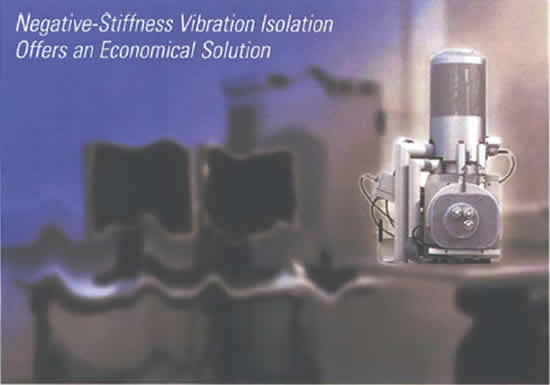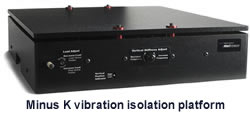
Laboratory Equipment - January 2007
SPECIAL FEATURE By Jim McMahon
Controlling Vibration in Nanotech Applications

It wasn't too long ago that making the decision where to locate your scanning probe microscope was a simple one-put it in the basement where ambient vibration was least. But recently, with nanotechnology applications growing exponentially, scientists and engineers are putting their equipment in locations where vibration noise is significantly high. Scanning probe microscopes, interferometers and stylus profilers are being sited in locations that pose a serious challenge to vibration isolation. Additionally, in an effort to keep their nano-equipmcnt costs as low as possible by cutting out the peripherals, many academics and industries are not adequately providing for vibration isolation on their ultrasensitive nano-cquipment.
Vibrations are usually very subtle. The noise that can create disturbance to an AFM or interferometer is caused by a multitude of things and does not originate from just one spot. External to the building, equipment may he influenced by vibrations from adjacent traffic, wind, construction and other elements. These influences cause lower frequency vibrations, which raise havoc with nano-instrumentation.
 An isolator is used to solve vibration problems, and how bad the problem is determines the solution. Since the 1960s, air tables have "been used for isolation. Basically cans of air, they are still the most popular isolators. But air tables with resonant frequencies at 2 to 2-1/2 Hz. can typically only handle vibrations down to about 8 to 10 Hz, not quite low enough for optimum performance with modern nano-equipment.
An isolator is used to solve vibration problems, and how bad the problem is determines the solution. Since the 1960s, air tables have "been used for isolation. Basically cans of air, they are still the most popular isolators. But air tables with resonant frequencies at 2 to 2-1/2 Hz. can typically only handle vibrations down to about 8 to 10 Hz, not quite low enough for optimum performance with modern nano-equipment.
In the early years of nanotechnology, research scientists were fond of suspending their very expensive AFMs from bungee cords hanging from the ceiling. Although some are still employing this technique, the numbers are dwindling. Many aren't willing to take that risk and have switched over to other isolation systems. One of those is active isolation, also known as electronic force cancellation. Active isolation uses electronics to sense the motion, and then puts in equal amounts of motion electronically to compensate, effectively canceling out the motion. Their efficiency is fine for application with the latest nanotechnology, as they can start isolating as low as 0.7 Hz, quite sufficient for isolating the lower frequencies that are so damaging to image clarity with SPMs and interferometers.
However, if some form of supplied energy is not needed to run an isolator, then problems of electronic dysfunctions and power modulations, which can interrupt scanning, can be eliminated. Negative-stiffness vibration isolation systems have become a growing choice for nanotechnology applications. Not only are they a workable vibration solution, but their cost is significantly less-up to one-third the price of active systems.
This is a passive approach for achieving low vibration environments and isolation against sub-Hertz vibrations," says Dr. David Platus, inventor of negative-stiffness mechanism vibration isolation systems, and president of Minus K Technology, Inc. These isolation systems enable vibration-sensitive instruments, such as scanning probe microscopes, micro-hardness testers and scanning electron microscopes, to operate in severe vibration environments, such as upper floors of buildings and clean rooms. The images and data produced are many times better than those achievable with pneumatic isolators."
micro-hardness testers isolators employ a completely mechanical concept in low-frequency vibration isolation. Vertical-motion isolation is provided by a stiff spring that supports a weight load, combined with a negative-stiffness mechanism (NSM). The net vertical stiffness is made very low without affecting the static load-supporting capability of the spring. Beam-columns connected in series with the vertical-motion isolator provide horizontal-motion isolation. The horizontal stiffness of the beam-columns is reduced by the "beam-column" effect. (A beam-column behaves as a spring combined with an NSM.) The result is a compact passive isolator capable of very low vertical and horizontal natural frequencies and very high internal structural frequencies. The isolators (adjusted to 1 /2 Hz) achieve 93% isolation efficiency at 2 Hz, 99% at 5 Hz, and 99.7% at 10 Hz.
"Improved vibration isolation directly correlates to improved instrument performance," says Patrick O'Hara, president and CEO of Ambios Technology, Inc., a manufacturer of SPMs, stylus profilers and optical interferometers used in nanotechnology. "When you are trying to measure atomic scale features, mechanically stable support structures are critically important."
"What negative-stiffness isolators provide is really quite unique to the field of nanotechnology," continues O'Hara. "In particular, the transmissibility of a negative-stiffness isolator-that is the vibration that transmits through the isolator as measured as a function of floor vibrations-is substantially improved over air or active isolation systems. Although active isolation systems have fundamentally no resonance, their transmissibility does not roll off as fast as negative-stiffness isolators. So, at building and seismic frequencies the transmissibility of active isolators can be 10X greater than negative-stiffness isolators. Air isolators have the added disadvantage that their 2 to 2-1/2 Hz resonance affects a significant loss in isolation capability below about 5 Hz. Negative-stiffness isolators are clearly the most efficient choice for probe microscopes."
Jim McMahon is a freelance, writer based in Simi Valley California. He may be contacted at jim.mcmahon@zebracom.net or by phone at 805-955-0009
|